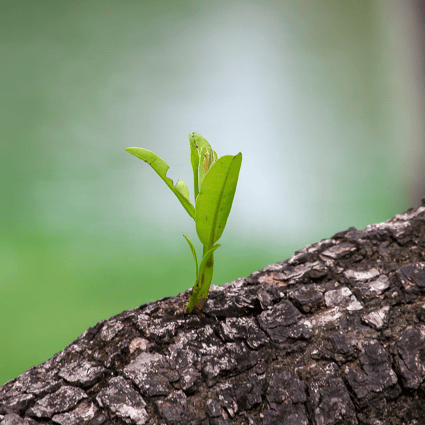
In 1912 the Titanic, that famous ship, struck an iceberg during the night in the icy North Atlantic Ocean. During the latter part of the last two hours and forty minutes, until the ship sank, the 8-member band played music on the deck to keep passengers calm and upbeat. What the band played as it went down is disputed. But from witnesses in lifeboats, the band played on, even as they were perishing.
No doubt that story is the context for the oft-used phrase, “rearranging the deck chairs on the Titanic.” It’s a reference to well-intended but short-sighted efforts to make minor organizational changes—tweaks, actually—in the looming shadow of much greater transformation that is needed.
Theory U: The Model
This blog post builds on my 6th podcast episode, Leading from the Future.
Economist Otto Scharmer at the Massachusetts Institute of Technology (MIT) developed a fascinating approach to decision-making and discernment that can be used by one person or an organization of any size. The model is based on several key stages during a process of reflection and visioning.
At a high level, the model has three stages forming the letter U:
- On the left-hand side, the downward movement of the U focuses on observing, Scharmer calls “Letting Go.”
- On the right-hand side, the upward movement of the U focuses on acting, which he calls “Letting Come.”
- At the bottom of the U is the area of “Presencing,” which is a space of reflection between observation and action.

Presencing
The word presencing is essentially a combination of two words: present and sensing; literally being present to all that you’re sensing. When you realize that the bottom of the U is where “Letting Go” and “Letting Come” share common space, the idea of presencing takes on more meaning.

“Letting Go” and “Letting Come”—in dynamic tension—are actually a polarity. With a polarity, both poles need to exist for the good of the whole. And as with any polarity, both poles are useful. However, either pole used to the extreme becomes unhealthy.
For more on polarities in leadership and life, see my blog post on that leadership approach.
Consider a life-long challenge that I’ve navigated.
As an Enneagram 7, I am drawn to the future (if you don’t know what “enneagram” means, reach out to me; I have a fun assessment that could change your life). What lies ahead is usually more interesting to me than what has already been. So adding new interests or hobbies—or commitments(!)—to my life creates a very full life! Life can become too interesting when a steady “Letting Come” of new things into my life gets over-used without some measure of “Letting Go.” And by too interesting, I mean it can be difficult to balance or do a decent job at any of them. There needs to be a letting go of some things in my life for new things to emerge.
A similar dynamic can play out with the other pole being overused. If I’m too attached to the familiar, to the way things have been and are currently; I am not likely to be open to what could be, to what is wanting to emerge or come into my life. This is true in both personal and organizational realities.
So Scharmer’s notion of presencing is being present simultaneously to what we sense needs “Letting Go” and what may be wanting to emerge (“Letting Come”). Reflection and Visioning. Past and Future.
However, the beauty and power of the Theory U model involve one’s ability to deepen the sense of awareness to both poles. Scharmer refers to this depth as “Source.” Scharmer has this to say about “Source”:
Metaphorically speaking, presencing is the capacity that allows us to operate from [an] extended notion of the source, to function as a watershed by sensing what wants to come forth and then allowing it to come into being. In other words, by bringing the water from the surrounding waterfalls to a single point, the pond fills and spills into the river, bringing it into being.
“Source” is that (usually) quiet and reflective space we occasionally find when we can do some deep pondering and imaging, complete with a constructive critique of what needs letting go, as well as a creative and bold imagining of what could be, of what we may need to “let come” into our life.
Three Openings
To deepen our quest for discernment and decision making, Scharmer suggests three openings needed to access Source: Mind, Heart, and Will.
 The first part of the journey down the “Letting Go” portion of the U can suspend judgment to be open to possibilities. Scharmer calls this having an Open Mind. Having an open mind means seeing with fresh eyes. The friend of an open mind is curiosity.
The first part of the journey down the “Letting Go” portion of the U can suspend judgment to be open to possibilities. Scharmer calls this having an Open Mind. Having an open mind means seeing with fresh eyes. The friend of an open mind is curiosity.
Yes, yes, curiosity allegedly killed the cat. But curiosity is vital to exploring beyond what we currently see and understand.
 The second opening is deeper—into the heart. An Open Heart is necessary to feel and care about what may need letting go and what else could be. The friend of an open heart is compassion. An open mind and an open heart combine thinking and feeling.
The second opening is deeper—into the heart. An Open Heart is necessary to feel and care about what may need letting go and what else could be. The friend of an open heart is compassion. An open mind and an open heart combine thinking and feeling.
 And the third opening is deeper still, into the very soul of our being: an Open Will. While Scharmer doesn’t necessarily make the direct comparison, I view the will in the gut. Current neuroscience studies increasingly and consistently confirm what we’ve hunched (get it?) all along. The stomach, our gut, plays a huge role in helping us make decisions.
And the third opening is deeper still, into the very soul of our being: an Open Will. While Scharmer doesn’t necessarily make the direct comparison, I view the will in the gut. Current neuroscience studies increasingly and consistently confirm what we’ve hunched (get it?) all along. The stomach, our gut, plays a huge role in helping us make decisions.
These three openings—mind, heart, and will—help us access new space. Space allows us to see, feel, and sense what to let go of to allow the new to emerge.
Our body does this with our cells all the time. Old cells are shed, and new cells are grown. This happens until the minute we pass on from this life.
Three Voices that Limit Our Depth
Our quest to go deep toward the Source of our being, toward clarity about who we are and why we’re here, so to speak, is inhibited by three voices that limit us and our ability to become more.
The first voice is the Voice of Judgment. This voice is consistently pre-judging, acting as if our past experience is always right. And while there’s an evolutionary reason for our capacity to judge things that are dangerous for us, there’s also a danger in not having an open mind.
As you know, having an open mind doesn’t mean you accept anything and everything. It’s actually quite the opposite. An open mind allows you to look at the facts, the argument, the possibilities, and then make a judgment. But our tendency to pre-judge is what limits us from seeing anew.
It’s healthy and vital to challenge ideas and beliefs about ourselves and others that no longer serve us.
The second voice is the Voice of Cynicism. The difference between cynicism and apathy is day and night. A cynic has typically been wounded and is angry, doubting, or distrusting. Someone who is apathetic has given up. You can work with a cynic, but it takes compassion. We can work with our cynical selves if we can open our hearts enough to have compassion for ourselves.
The voice of cynicism says, “We’ve already tried that, and it didn’t work.” A heart filled with cynicism finds it difficult to try again, to let go of the hurt enough to try again (and again).
Having an open mind allows us to let go enough to experience the possibility of an open heart. Both of those openings will enable us to work toward an open will.
However, the Voice of Fear is that third voice that keeps us from acting, from being fully open to the fruit of what is wanting to come, wanting to emerge.
Even with the curiosity of an open mind and compassion of an open heart, the voice of fear can keep us from having the courage to have an open will, that necessary component to living fully into what is wanting to emerge.
The graphic below illustrates not only the three primary movements of the U—observing/letting go, reflection/presencing, and action/letting come—but it also layers on the three openings (mind, heart, and will) as well as the three voices (judgment, cynicism, and fear) that can limit being open.

In the diagram on the far right of the graphic, you'll also notice that the deeper you descend into the U—that is, with an open mind, an open heart, and an open will—the more profound can be the impact of the action. Continuing to do what is already known is called re-acting; you could also call it re-enacting, as in, re-enacting each morning how I tie my shoes. There is no reason to reinvent every morning how I tie my shoes.
As we go deeper into the U, we move from simply re-acting/re-enacting to re-structuring. We might restructure how we run our busy lives to help us feel more efficient, but if we have added new without letting go of the existing/old, we still feel overwhelmed.
Deeper still takes us into the space of re-designing, which can be markedly different than simply restructuring, but perhaps only be degree. Redesigning without fundamentally changing what we’re working with may be helpful, but like restructuring, it often doesn’t go deep enough to make a meaningful difference.
The final two “re” words, re-framing, and re-generating, are evidence of depth, of discerning and deciding from a place of true reflection.
Reframing suggests not only repositioning what already is but understanding what it means to reconsider the purpose of someone’s life or an organization’s role in the world. It requires not only rearranging things but backing up or going deep enough to understand the significance at stake.

Regenerating goes even one layer deeper, and for me, conjures the image of a tree stump regenerating the essence of what that tree has always been about, but under new conditions.
With the curiosity of an open mind, the compassion of an open heart, and the courage of an open will, we can look again at true purpose. We can assess both what to let go of and what to let come and do so from a place of depth.
Ideally, this involves time, like a day off or a leadership retreat, or a sabbatical of some kind. But with focus and intentionality, it can happen in an hour. Or in multiple hours spread over months.

Instead of recapping what I shared here, I summarize with a story.
Just before the start of the Covid-19 pandemic, I began working with an organization on what was to be a 20-month project to help them redesign who they were and gain clarity on where they were heading. We launched the process in late fall of 2019, and by March and April 2020, we realized we needed to redesign the redesign process! By the summer of 2020, it was becoming clear that even a redesign wouldn’t be enough.
Spurred by a crisis, the organization’s leaders kept an open mind and an open heart for whom they were planning to serve. And by the fall of 2020, they had the courage to have an open will.
The organization’s leaders not only “restructured” how they would serve those they had previously served but went much deeper to a place of Source. Who are we? Why are we here? Whom do we serve?
From there, they regenerated why they existed in the first place and started their new, courageous—and risky—direction. They decided that Covid-19 was not only a setback but also an opportunity. And they embraced it with curiosity, compassion, and courage. With that, they faced down judgment, cynicism, and fear. They are now positioned for what is emerging.

Next month we’ll explore The Speed of Trust, an approach by Stephen M.R. Covey. The model is both practical and profound. Stay in touch!

-
Presence: Human Purpose and the Field of the Future (With Peter Senge, Joseph Jaworski, & Betty Sue Flowers; 2004)
-
Presencing Institute Website
- Episode 6 of Leadership Meets Life Podcast: Leading from the Future

- What aspect of your life needs an open mind, heart, and will in order for you to regenerate who you are?
- What does your organization need to let go of in order for new things to emerge?
Let me know how you’re connecting with the Leadership Meets Life Blog and Podcast. I’d love to hear from you! You can reach me directly at philb@designgroupintl.com or by visiting my website.
Tags:
polarity management, leadership, Organizational development, change, learning, growth, polarities, Letting Come, Mind, Heart, Will, Theory U, presencing, Letting Go, Leadership Meets Life Blog/Philip%20C.%20Bergey%20Headshot%20(300x300).png)
September 28, 2021
.png?width=100&name=Phil%20Bergey%20Headshot%20(1).png)





Comments